Triumph Herald 1200 12/50
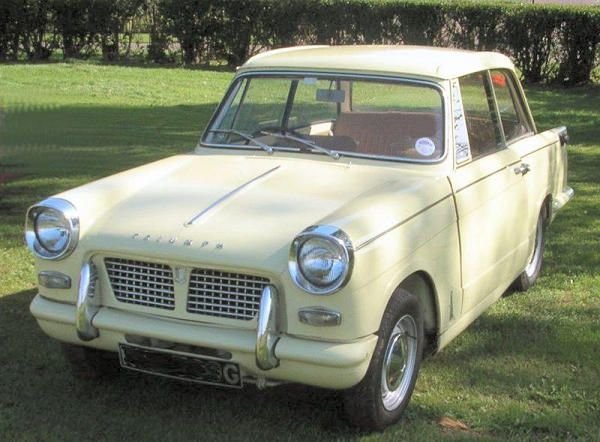 |
|
| Overview | |
|---|---|
| Manufacturer | Standard-Triumph |
| Also called | Triumph 12/50 (Australia) |
| Production | 1959 to 1969 |
| Body and chassis | |
| Body style | 2-door saloon 2-door coupe 2-door convertible 2-door van 2-door estate car |
| Layout | FR layout |
| Related | Triumph Vitesse Triumph Spitfire Triumph GT6 |
| Powertrain | |
| Engine | 948 cc OHV I4 1147 cc OHV I4 (Herald 1200 & 12/50) |
| Transmission | 4-speed manual (synchromesh on 2nd 3rd and top gears, no overdrive) |
| Dimensions | |
| Wheelbase | 91 in (2,311 mm) |
| Length | 153 in (3,886 mm) |
| Width | 60 in (1,524 mm) |
| Height | 52 in (1,321 mm) |
| Kerb weight | 725 kg (1,600 lb) (1200 convertible) to 865 kg (1,910 lb) (13/60 estate) |
The Triumph Herald is a small two-door car introduced in 1959 by the Standard-Triumph Company of Coventry. Body design was by the Italian stylist Giovanni Michelotti, and the car was offered in saloon, convertible, coupé, van and estate models.
Total Herald sales numbered well over 500,000, and Heralds are still seen on British roads in the early 21st century. The Vitesse, Spitfire and GT6 are all based on modified Herald chassis and running gear with bolt-together bodies.Towards the end of the 1950s Standard-Triumph offered a range of two-seater Triumph sports cars alongside its Standard saloons, the Standard 8 and 10, powered by a small (803 cc or 948 cc) 4-cylinder engine, which by the late 1950s were due for an update. Standard-Triumph therefore started work on the Herald. The choice of the Herald name suggests that the car was originally intended to be marketed as a Standard, as it fits the model-naming scheme of the time (Ensign, Pennant and Standard itself). But by 1959 it was felt that the Triumph name had more brand equity, and the Standard name was phased out in Britain after 1963.

Giovanni Michelotti was commissioned to style the car by the Standard-Triumph board, encouraged by chief engineer Harry Webster, and quickly produced designs for a two-door saloon with a large glass area that gave 93 per cent all-round visibility in the saloon variant and the "razor-edge" looks to which many makers were turning. As Fisher & Ludlow, Standard-Triumph's body suppliers became part of an uncooperative BMC, it was decided that the car should have a separate chassis rather than adopting the newer monocoque construction. The main body tub was bolted to the chassis and the whole front end hinged forward to allow access to the engine. Every panel – including the sills and roof – could be unbolted from the car so that different body styles could be easily built on the same chassis. Accordingly, in addition to the original coupé and saloon models, van, convertible and estate versions were on offer within two years.
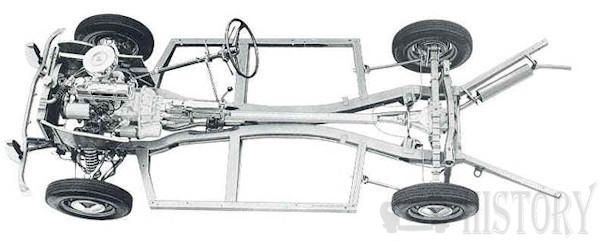
The Standard Pennant's 4-cylinder 948 cc OHV engine and 4 speed manual gearbox was used with synchromesh on the top three gears and remote gear shift and driving the rear wheels. The rack and pinion steering afforded the Herald a tight 25 feet 0 inches (7.62 m) turning circle. Coil and double-wishbone front suspension was fitted, while the rear suspension, a new departure for Triumph, offered independent springing via a single transverse leaf-spring bolted to the top of the final drive unit and swing axles.
Instruments were confined to a single large speedometer with fuel gauge in the saloon (a temperature gauge was available as an option) on a dashboard of grey pressed fibreboard. The coupé dashboard was equipped with speedometer, fuel and temperature gauges, together with a lockable glovebox. The car had loop-pile carpeting and heater as standard. A number of extras were available including twin carburettors, leather seats, a wood-veneered dashboard, Telaflo shock absorbers and paint options.
In late 1958, prototype cars embarked on a test-run from Cape Town to Tangiers. An account of the journey was embellished by PR at the time. However only minor changes were deemed necessary between the prototype and production cars. The new car was launched at the Royal Albert Hall in London on 22 April 1959 but was not an immediate sales success, partly owing to its relatively high cost, approaching £700 (including 45 per cent Purchase Tax). In standard single-carburettor form the 34.5 bhp (26 kW) car was no better than average in terms of performance. A saloon tested by The Motor magazine in 1959 was found to have a top speed of 70.9 mph (114.1 km/h) and could accelerate from 0–60 mph (97 km/h) in 31.1 seconds. A fuel consumption of 34.5 miles per imperial gallon (8.2 L/100 km; 28.7 mpg-US) was recorded.
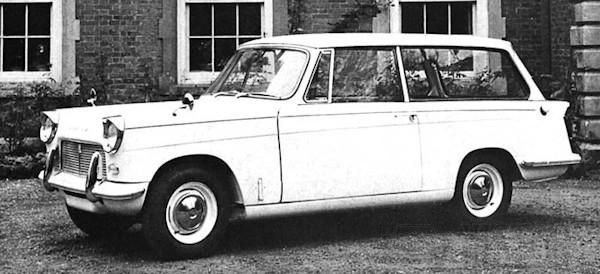
The rear suspension was criticised as yielding poor handling at the extremes of performance though the model was considered easy to drive with its good vision, light steering (smallest turning circle of any production car) and controls, and ease of repair.
Triumph Heralds were exported and assembled in a number of countries, and the separate chassis used as a jig to assemble kits exported from Coventry. These cars were referred to as CKD – Complete Knock Down cars.
In the 1960s Standard Motor Products of Madras, India manufactured Triumph Heralds with the basic 948 cc engine under the name Standard Herald, eventually with additional four-door saloon and five-door estate models exclusively for the Indian market. In 1971 they introduced a restyled four-door saloon based on the Herald called the Standard Gazel, using the same 948 cc engine but with the axle changed to that of the Toledo, as the Herald's "swing-arm" could not cope with India's poor roads. The Gazel was discontinued in 1977.Triumph Heralds were also assembled in South Africa, New Zealand, Ireland, Malta, Sri Lanka, and at two locations in Peru.
The Herald was produced in Australia by Australian Motor Industries from 1959 to 1966 with output totalling 14,975 units. Production included a 12/50 model, which unlike its English namesake was offered in both saloon and coupe body styles. It featured the bonnet and four angled headlights of the Triumph Vitesse and was marketed as the Triumph 12/50, without Herald badges.
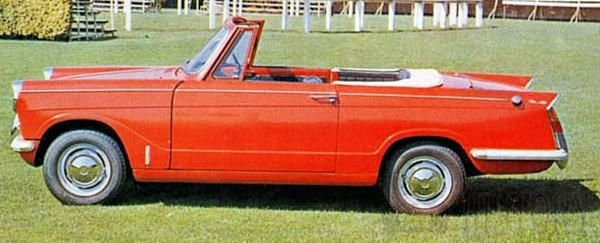
Herald 1200
Standard-Triumph experienced financial difficulties at the beginning of the 1960s and was taken over by Leyland Motors Ltd in 1961. This released new resources to develop the Herald and the car was re-launched with an 1147 cc engine as the Herald 1200. The new model featured white rubber bumpers, a wooden laminate dashboard and improved seating. Quality control was also tightened up. Twin carburettors were no longer fitted to any of the range as standard although they remained an option, the standard being a single down-draught Solex carburettor. Claimed maximum power of the original Herald 1200 was 39 bhp ) later to 43 hp . Disc brakes also became an option from 1962.
- PERFORMANCE:
- engine capacity 70.15 cu in, 1147 cu cm
- fuel consumption 41.5 m imp gal, 34.6 m US gal, 6.8 1x 100 km
- max speed 77 mph, 124 km h
- max power (SAE): 43 hp at 4500 rpm
- max torque (SAE): 68 1b ft, 9.4 kgm at 2250 rpm
- max number of engine rpm: 5800
- specific power: 37.5 hp/l
- power-weight ratio: 39.7 ib hp, 18 kg/hp
- acceleration: standing 1/4 mile 0-50 mph (0-80 km/h) 17.5 sec
Sales picked up despite growing competition from the BMC Mini and the Ford Anglia. The convertible was popular as a 4-seater with decent weatherproofing and the estate made a practical alternative to the Morris Minor Traveller. The coupé was dropped from the range in late 1964 as it was by then in direct competition with the Triumph Spitfire.The Triumph Courier van, a Herald estate with side panels in place of rear side windows, was produced from 1962 until 1966, but was dropped following poor sales. Production in England ceased in summer 1964. CKD assembly by MCA in Malta continued till late 1965, at least.
Herald 12/50
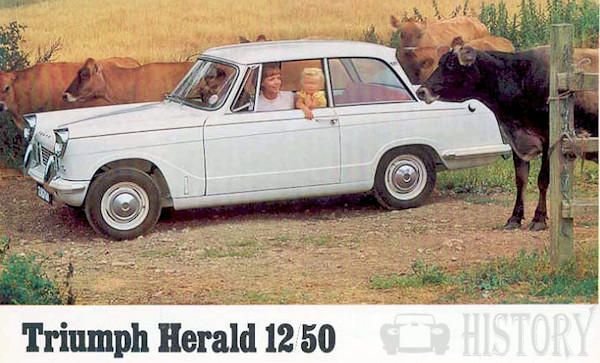
A sportier version, the Herald 12/50 Skylight Saloon, offered from 1963–67, featured a tuned engine with a claimed output of 51 bhp (38 kW) in place of the previous 39, along with a sliding (Webasto) vinyl-fabric sunroof and front disc brakes as standard. The 12/50 was fitted with a fine-barred aluminium grille. The power output of the 1200, which remained in production alongside the 12/50, was subsequently boosted to 48 bhp.
PERFORMANCE:Triumph Herald 12/50
- engine capacity 69.99 cu in, 1,147 cu cm
- fuel consumption 39.8 m/imp gal, 33.1 m/US gal, 7.1 1 x 100 km
- max speed 80 mph, 128.8 km/h
- max power (DIN): 48 hp at 5,200 rpm
- max torque (DIN): 62 1b ft, 8.6 kg m at 2,500 rpm
- max engine rpm: 5,700
- specific power: 41.8 hp/l
- power-weight ratio: 37 lb/hp, 16.8 kg/hp
- acceleration: standing 1/4 mile 23.1 sec, 0—50 mph (O—80 km/h) 15.5 sec
In popular media
A Triumph Herald was used at the 2012 London Olympic Games during the beginning of the Closing Ceremony when cars were paraded around the stadium.
A yellow 1961 Triumph Herald was driven in the Heartbeat series by leading characters Nick and Kate Rowan. The car was last seen offered up for sale recently but with serious work needing to be done to it.
A Herald was used by James May on the TV car show Top Gear as a template for an amphibious car. It was used in the third episode of series 8, in which it and May were victorious in the featured challenge of crossing a 2-mile (3.2 km) lake. It was again seen in the second episode of series 10, in which May used exactly the same car from the previous amphibious car challenge and attempted to cross the English Channel. The car is now a part of the scenery within the Top Gear studio.
The character of Edie Pegden (played by Thora Hird) in the BBC 1 long-running comedy Last of the Summer Wine drove a red Herald convertible.
A red Herald 1200 Convertible was driven by David Niven in the 1975 film: Paper Tiger.
A Triumph Herald Convertible in Two for the Road movie from 1967
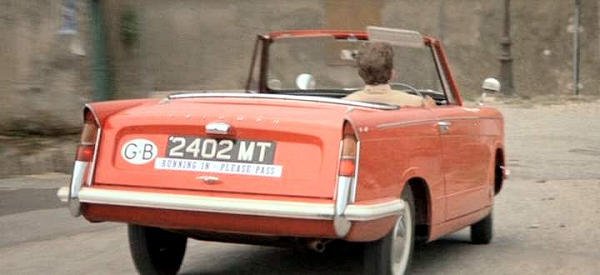
A Triumph Herald 1200 in the Heartbeat, TV series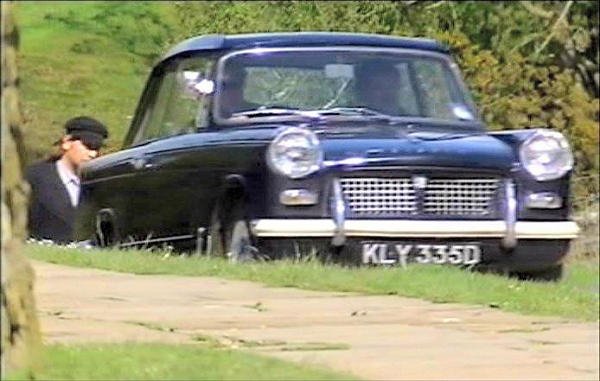
Technical
-
Triumph Herald 1200 12/50 Technical details and specifications (1959-1969)
ENGINE: Triumph Herald 1200
location front, 4 stroke
cylinders: 4, vertical, in line
bore and stroke: 2.72 x 3.00 in. 69.7 x 76.2 mm
engine capacity: 70.15 cu in, 1147 cu cm
compression ratio: 3:1
cylinder block: cast iron
cylinder head: cast iron
crankshaft bearings: 3
valves: 2 per cylinder, over- head, in line, push-rods and rockers
camshafts: 1, side
lubrication: rotary pump, full flow filter
carburation: 1 Solex B 28 ZIC downdraft single barrel carburettor
fuel feed: mechanical pump
cooling system: water
ENGINE: Triumph Herald 12/50
location front, 4 stroke
cylinders: 4, vertical, in line
bore and stroke: 2.73 x 2.99 in, 69.3 x 76 mm
engine capacity: 69.99 cu in, 1,147 cu cm
compression ratio: 8 (option) 7
cylinder block: cast iron
cylinder head: cast iron
crankshaft bearings: 3
valves: 2 per cylinder, over- head, in line, push-rods and rockers
camshafts: 1, side
lubrication: rotary pump, full flow filter
carburation: 1 Solex B 30 PSE 1 downdraught single barrel carburettor
fuel feed: mechanical pump
cooling system: waterTRANSMISSION
driving wheels: rear
clutch: single dry plate, hydraulically controlled
gearbox: mechanicalgears: 4+ reverse
synchromesh gears: 2nd, 4th
gearbox ratios: I 3.746, II 2.158, III 1.394, IV 1, rev 3.746
gear lever location: central
final drive: hypoid bevel
axle ratio: 4.110CHASSIS
type double backbone, channel section with outriggers
front suspension: independent, wishbones, coil springs, anti-roll bar, telescopic dampers
rear suspension: independent, swinging semi-axles, transverse leafspring upper arms, swinging longitudinal trailing arms, telescopic dampers.
(option) heavy-duty dampersSTEERING
rack-and-pinion, adjustable steering wheel
turns of steering wheel lock to lock: 3.75
turning circle (between walls): 25 ft, 7.6 mBRAKES
drum, 2 front leading shoes
lining area: total 73 sq in, 470.85 sq cm.
(option) Front disc brakes, diameter 7.48 in, 190 mm
total area rubbed by linings 199 sq in, 1,283.55 sq cmELECTRICAL EQUIPMENT
voltage: 12 V
battery: 43 Ah
generator type: dynamo, 264 W
ignition distributor: LucasDIMENSIONS AND WEIGHT
wheel base: 91.34 in, 2,320 mm
front track: 48.05 in, 1,220 mm
rear track: 48.05 in, 1,220 mm
overall length: 153.15 in, 3,890 mm
overall width: 60.05 in, 1,525 mm
overall height: 51.95 in, 1,319 mm
ground clearance: 6.70 in, 170 mm
dry weight: 1,779 1b, 807 kg
distribution of weight: 53% front axle, 47% rear axle© Motor car History
Service
-
Triumph Herald Maintenance and Service Guide (1959-1969)
Triumph Herald 1200
engine oil change: 3.5 imp qt, 4.2 US qt SAE 20, change every 3000 miles, 4800 km
gearbox oil: 0.7 imp qt, 0.8 US qt. 0.8 1, SAE 90, change every 12000 miles, 19300 km
final drive oil: 0.5 imp qt, 0.6 US qt, 0.6 1, SAE 90, change every 12000 miles 19300 km
greasing: every 12000 miles, 19300 km, 6 points
tappet clearances: inlet 0.010 in, 0.25 mm, exhaust 0.010 in, 0.25 mm
valve timing: (inlet) opens 12° before tdc and closes 52° after bdc, (exhaust) opens 52° before bdc and closes 120 after tdc
tyre pressure (normal load): front 19 psi, rear 24 psi, 1.7 atm.Triumph Herald 12/50
Gearbox oil: 1.41 imp pt, 1.69 US pt, 0.8 1, SAE 90
Final drive oil: 1.06 imp pt, 1.27 US pt, 0.6 1, SAE 90
Greasing: none
Normal tyre pressure: front 19 psi, 1.3 atm. rear 24 psi, 1.7 atm.
Width of rims: 3.5"
Tyres: 5.20 x 13 (option) 5.60 x 13 tyres.
Fuel tank capacity: 6.5 imp gal, 7.9 US gal
Carrying capacity: 706 1b, 320 kg
Fuel type: 95 oct petrol
Engine oil change: 7.57 imp pt, 9.09 US pt, 4.3 1, SAE 20, change every 6,000 miles, 9,700 km
Total lubricating system capacity: 7.92 imp pt, 9.51 US pt
Cooling system capacity: 8.45 imp pt, 10.15 US pt
Tappet clearances: inlet 0.010 in, 0.25 mm, exhaust 0.010 in, 0.25 mm;
Valve timing: inlet opens 12° before tdc and closes 52° after bdc, exhaust opens 52° before bdc and closes 12° after tdc© Motor car History
